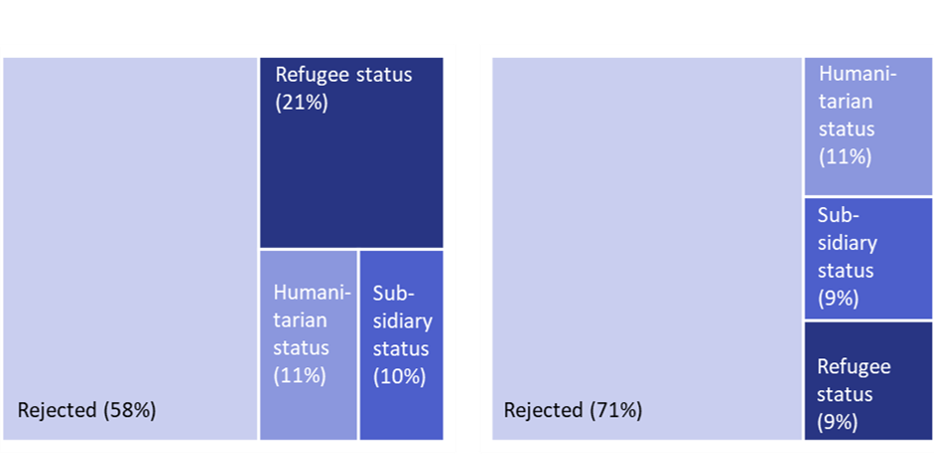

Persons issued a positive decision are granted a form of protection in EU+ countries which entails a set of rights and obligations and access to a number of services. A positive decision is a decision that grants refugee status, subsidiary protection (both regulated in the EU law) or humanitarian protection (granted under national law). The recognition rate refers to the number of positive decisions as a percentage of the total number of decisions on applications for international protection.
In 2020, the EU+ recognition rate for first instance decisions on asylum applications was 42%: out of 534,500 decisions issued, 224,000 were positive and the applicant was granted a form of protection. Most positive decisions at first instance granted refugee status (113,000 or one-half of all positive decisions). Subsidiary protection was granted in about 52,000 cases (23% of all positive decisions), while humanitarian status was granted in 59,000 cases (27% of all positive decisions) (see Figure 2).
| A. Decisions at first instance | B. Decisions at second or higher instances |

Source: Eurostat [migr_asyappctzm] as of 28 April 2021.
At second or higher instances, the 237,000 decisions issued in EU+ countries included 70,000 positive decisions, resulting in a recognition rate of 29%. Positive decisions at second or higher instances most often granted humanitarian status (26,000), while refugee status and subsidiary protection represented somewhat fewer cases (22,000 each).
The extent and quality of rights and services that beneficiaries of protection receive shape the prospects of their effective integration in the new societies. In 2020, some countries introduced measures to regularise the situation of specific groups of foreigners. Some initiated changes to facilitate family reunification for beneficiaries of international protection and provided clarifications on the process through more detailed guidance, while courts remained active in shaping policies and practices on family reunification. At the same time, trends from previous years continued pointing towards an increased use of status reviews and more rigorous use of cessation and revocation grounds.
The drafting and launching of the new EU Action Plan on Integration and Inclusion provided further guidance for integration strategies at the national level. EU+ countries continued their efforts to support beneficiaries through language learning, access to education and vocational training, employment opportunities, and socio-cultural orientation, with a recent shift toward personalising integration plans tailored to the needs of individual beneficiaries. Efforts have intensified in recent years to evaluate integration plans through interdisciplinary research in order to assess the effect of existing policies and offer recommendations for the future. An area of concern in 2020 was the disruptions caused by the COVID-19 pandemic in the effective access to education for refugee children, with a number of stakeholders calling for swift remedies to avoid long-term consequences.
An ongoing concern is the situation of persons who have been granted international protection in one Member State but then moved and applied for asylum again in another one. The occurrences are of increasing importance for some Member States and were highlighted in the political debates of the 2016 reform proposals and the Pact in Migration and Asylum.
 |
........ |
|
 |
|
........ |  |
| EASO Asylum Report 2021 | ||||||

